hitch route
This space has seen epic amounts of bitching about Michigan's failure to check into easy plays that would get some yards and pressure a defense to the edge, but at least once in the Indiana game they did that in a fashion that still kind of baffles me. Michigan's driving to take a 21-7 lead and finds themselves with first and ten on the IU 24.
Michigan comes out in a shotgun with three wide; Indiana goes with the same response they did all day: two deep safeties and a hybrid space LB shaded over the slot.
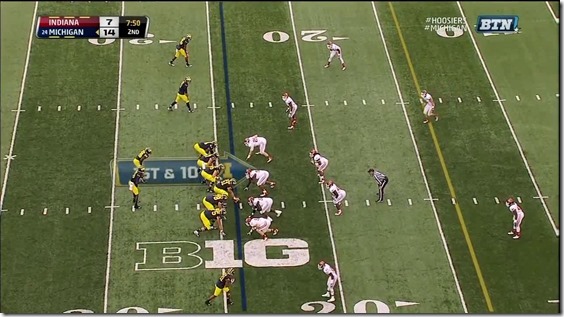
To everyone on Michigan's offense other than Jeremy Gallon and Devin Gardner, this is going to be an inside zone. Gallon and Gardner are going to run a pop pass hitch, because they are spooky.
So. Presnap, Gardner starts scoping out the boundary corner. A lot of teams will blitz that guy to combat spread looks; Michigan's seen it frequently and hasn't had an answer. This is one, but I'm kind of at a loss to tell you how Michigan read it. Whatever Gardner's reading here is subtle.
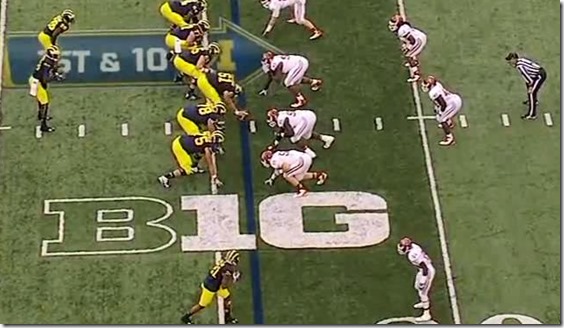
He's making some sort of hand motion to Gallon here.
On the snap, Gardner takes a momentary glance back at that corner. This is an instant, and the guy hasn't had the time to indicate he's coming. He's not focused on Gallon, but a glance this quick could miss something there.
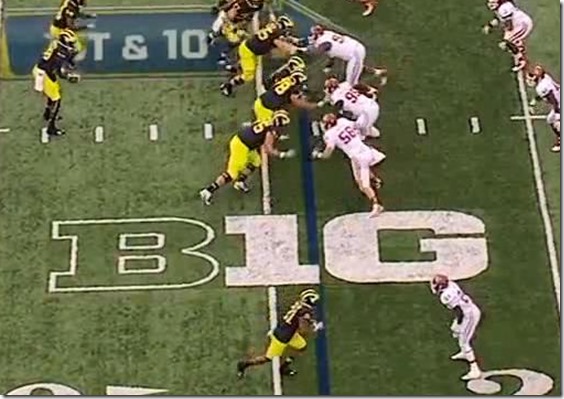
Gardner fakes a handoff; line run blocks, with Lewan getting a couple yards downfield eventually.
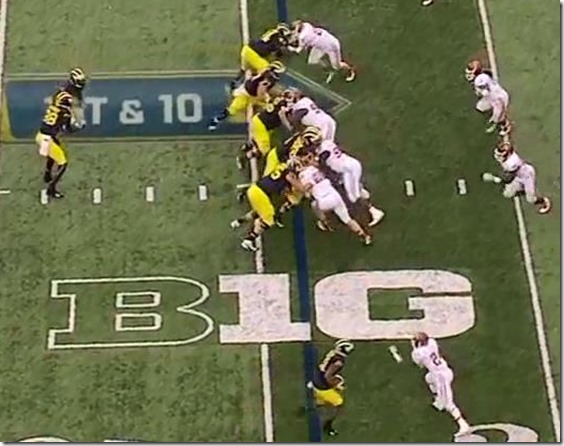
The CB now commits to his blitz; Gardner pops up and hits the open Gallon for a few yards.
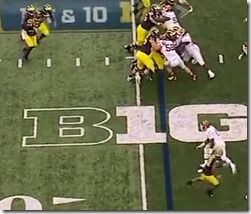
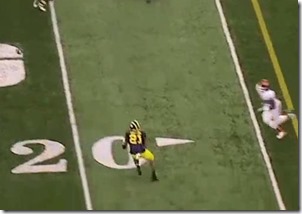
Except Gallon is good, man, and Indiana's safety gets shook, turning seven yards into 17.
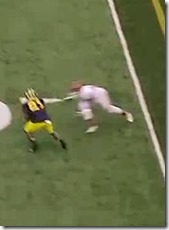
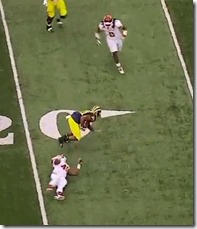
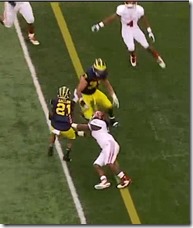
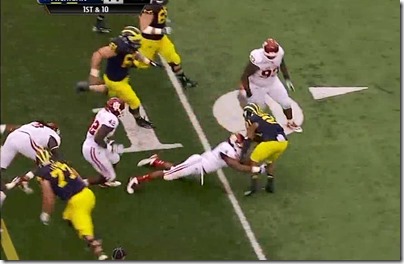
Video
Items of Interest
Pop pass FTW. For a team that seems to be allergic to quick presnap reads for its quarterback this is some advanced stuff. If the corner tips his blitz here that's a tendency I can't pick up; Michigan must have seen something in their prep, or Gardner just feels it. I looked at this a dozen times trying to figure out the exact thing that tipped Gardner and still bupkis. There was a time during my odyssey that I thought it was just a called play, but no, that hand motion Gardner makes before the snap (not the one for the snap, the little indicator to Gallon) seems like a one-to-one check.
Either way, this is a response to the corner blitzes that earlier in the year would wreck Michigan's rudimentary spread running game, which is good to see. Point Borges. It's also a short quick throw that gets an athletic guy in space, which pays off with ten extra yards.
Crouching Gallon, Hidden Yards. Man is Gallon good at this method of getting yards after the catch. He's built low to the ground and has a knack for taking a hit when he's bent low, which gets him under the defender and allows him to spin to keep his feet. The middle frame of the triptych above is the Hypothetical Gallon Statue in my mind: he's just dusted a defender and is sneaking his way for YAC.
This is not quite a packaged play. Everyone on the college football internet just thinks whatever Smart Football thinks, so a favorite topic these days are "packaged plays," which are run plays paired with a quick hot read the QB takes if a particular player (usually an OLB) crashes to the run. A lot of these end up looking like those PA spread passes up the seam. These plays feature an offense that runs a run play and a quarterback and WR who are given the option to abort.
Here Michigan aborts a run play, but it appears the call is made presnap, not post-snap. So not quite packaged. A close relative, certainly.
Brandon Herron picked up a lot of minuses yesterday but it could easily have been Kenny Demens if he was the guy tasked with hauling ass to a far, far away zone coverage instead of making Alex Carder spit blood. He was given a tough job.
But he didn't execute that tough job, and we remain a results-based charting service. The good news is that he did get better at not executing his tough job. If you're looking for evidence that this coaching staff is better than the last one at teaching people how not to be terrible defensive players, here's some hope for you.
I found two plays that were exact replicas of each other. It's third down on one hash in both. WMU is in a four-wide shotgun while Michigan deploys its Okie package. Michigan will send wide-side blitzers and Brandon Herron will be directed to drop into a zone on the other hash—IE, run halfway across the field. WMU completes both passes, but Herron gets better.
Play The First
You are focused entirely on Herron, who is on the near hash in front of Demens, threatening blitz:
On the snap Heron pivots as Demens comes; RVB drops in to a short zone as Michigan sends five:
Herron crosses the hash marks three yards off the LOS:
Still three yards:
Now he's maybe three and a half yards deep and not even to the midway point as Carder cocks to throw the hitch to the slot.
Two other things to note:
- Gordon got a free run at Carder but slips as he moves in for a killshot. If he doesn't, he's likely to bat the pass or sack Carder.
- RVB is totally cutting off the other inside hitch, though his back is to the QB.
As the ball goes over Herron's head he's four or five yards deep, still not to the other hash, and not facing the quarterback:
First down.
Play The Second
This is going to be the exact same play by both teams. WMU runs the same all-hitch; Michigan runs the same zone blitz behind it. It's third and four on WMU's first drive of the second half. Herron is below the bottom hash this time.
As the snap reaches the QB Herron is pivoting…
…and on step two he's already got a yard of depth:
By the time the WR cuts off the route he's at the spot he was when the ball went over his head last time:
Important: this hitch is seven yards and the previous one was ten. The extra two steps the WR would take to get to the depth on the previous play would also get Herron all the way to the hash, whereupon he could give that WR the business. He's closer and a bit deeper earlier in the play.
You can see the improvement in the zone drop in the next frame, when the ball is halfway to the WR. Herron is right there:
Unfortunately he's had to run hash to hash with his back to the QB and never turns around.
First down again.
Object Lessons
A primary disadvantage of zone blitzing is having to haul ass so hard you can't look at the QB. You can see this in RVB's drops both times, too: when you're dropping into a surprising zone far away from where you start the play in order to facilitate QB pressure you can't just shuffle backwards like a linebacker, keeping your eyes on the QB and the receivers in front of you. To even get in the area you have to turn your back to the world and then whip around when it seems like the right time.
This seems hard. (Todd Howard is nodding his head right now.) Certainly we don't see it happening on either of the plays above. This is probably easier in the NFL when everyone's more athletic—and it may be an argument for the fastest, whippiest WLB Michigan can throw out there.
If your zone blitz works the pressure you get is often coming from the same area the open guy is. On the first play Thomas Gordon is in free. If he keeps his feet he's got a great shot at batting the ball skyward. A guy leaping at the QB may cause a delay. In a normal blitz package this might not get you much, but with Herron rotating over lateness is dangerous for an offense.
It doesn't take much for late to be late. Carder is late on the second play. You can see that on the frame where he's in his throwing motion: the WR has already settled and is looking for the ball. If he's on time the argh about Herron not turning around in the next frame is considerably reduced.
If offenses execute perfectly there's not much you can do about them, but offenses do not execute perfectly and defense is all about giving little margin for error. Michigan did a much better job of that on the second play than the first.
They're learning. This is good and bad. You could see the confusion on the first drive, the big errors that got a little smaller as the day went along. But if we're looking for evidence that this year's coaching staff is more adept at doing things other than preserving their meticulous hair, we've got a couple examples.
Okay, so we've just taken a spin through Michigan's hitch-susceptible cover three. What's the alternative? The Big Ten Network did give us one replay of something different. It comes on third and long in the third quarter with Michigan on offense. Threet is going to throw a hitch to Darryl Stonum.
(This camera angle is wider so I've cropped the pictures down; it'll be slightly fuzzy.)
This is pretty much the same as the first frame we saw with Morgan Trent earlier, except the defensive back is lined up a little further inside.
The Purdue corner turns his hips towards the receiver and looks directly at him. This is man coverage.
When Stonum starts making his break it's immediately apparent to the corner and he can turn his hips towards the receiver. Trent had to turn around the other way, taking himself away from the receiver until he can get his body around.
The ball from Threet is low and inside and gets marked IN in UFR, but Stonum still has a chance at a diving grab…
…but the Purdue defender is right there making life difficult. If the ball was better thrown he had a chance at a breakup or even an interception.
Here's the video on this one:
So it's pretty obvious why Purdue was able to play this sort of tight coverage on third and long: Michigan's receivers don't seem like much of a downfield threat and this guy has safety help over the top, a luxury not afforded Michigan's corners on the regular.
Okay. Question: does Michigan's coverage style (here's another example from Cissoko) make any sense given the defense they're running? I'm not a coach, but doesn't it seem like Michigan corners should be setting up outside of the receivers and funneling them towards the safety and/or zone dropping flex players and linebackers? Maybe Shafer thought Siller couldn't throw well enough to make him pay. He was wrong.
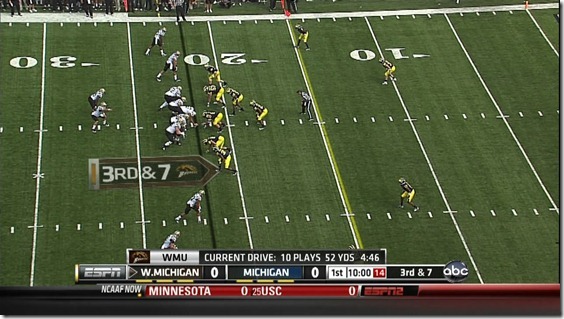


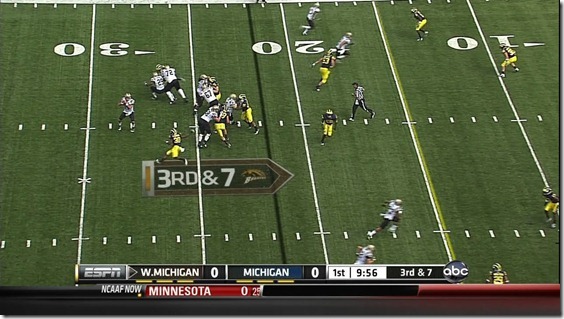


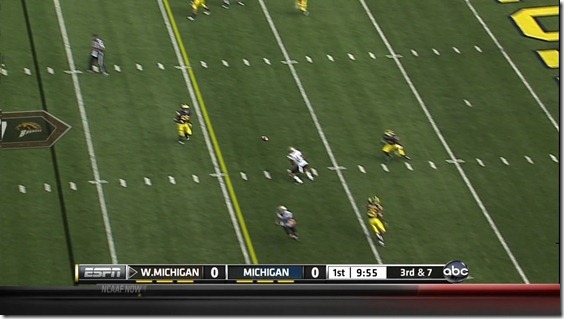

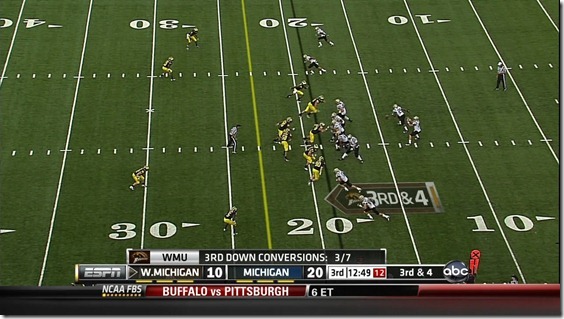
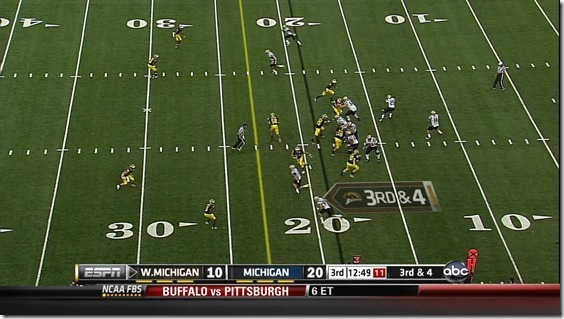
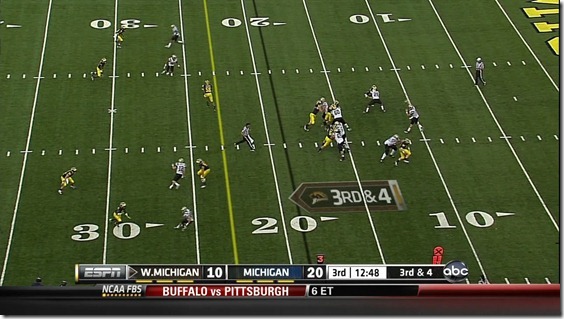
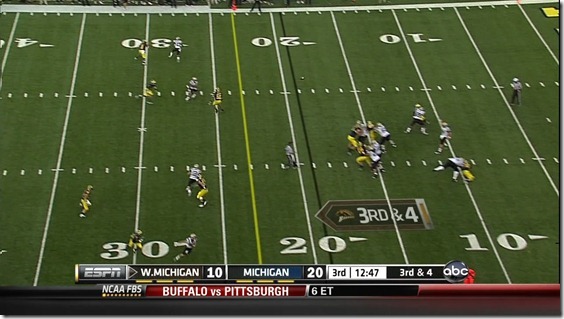
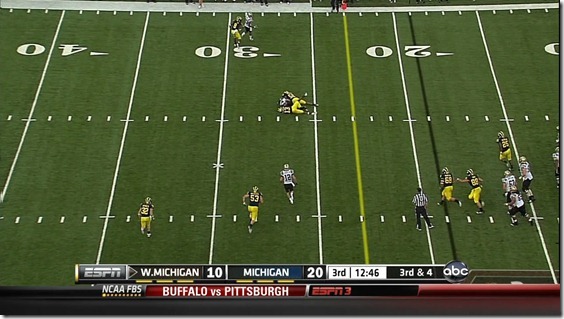

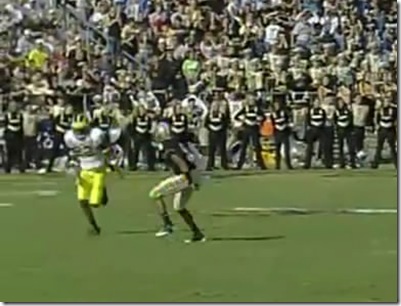
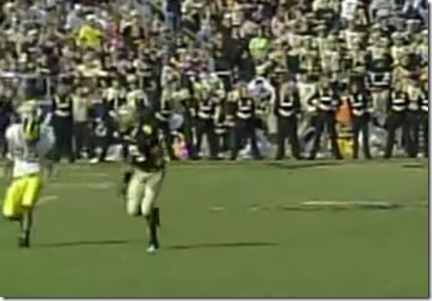
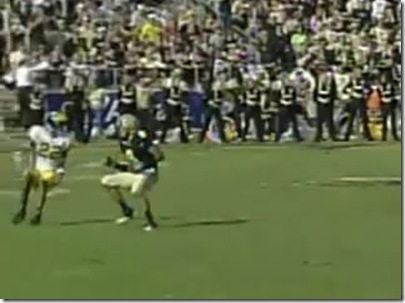

41